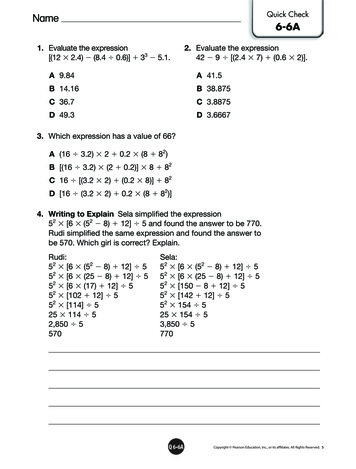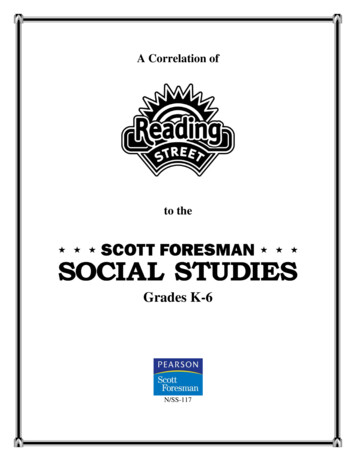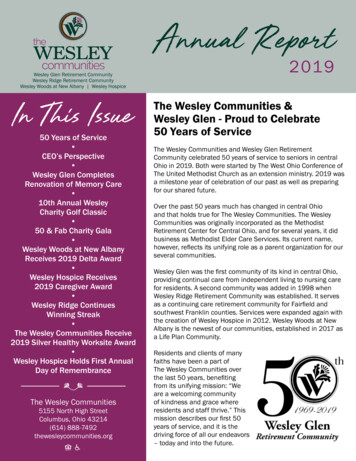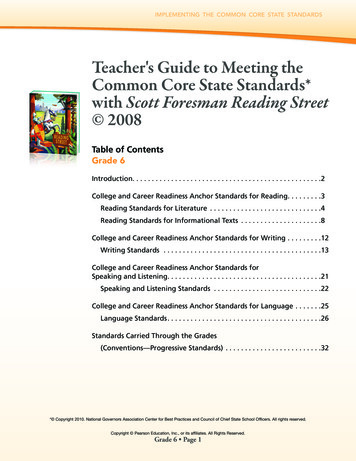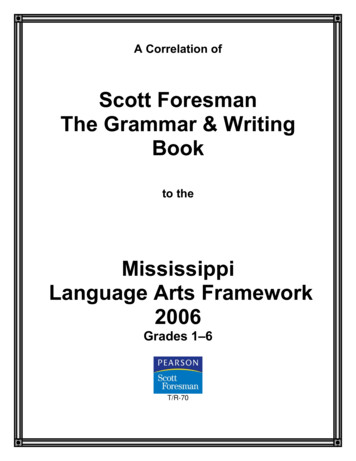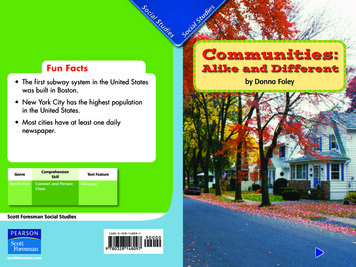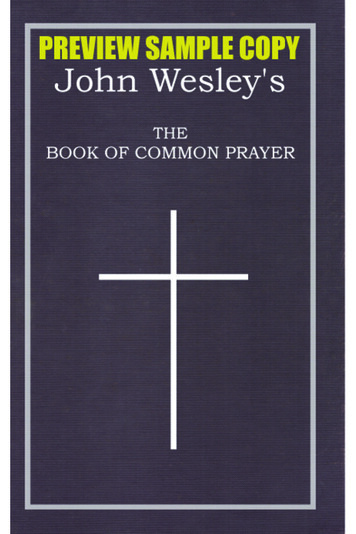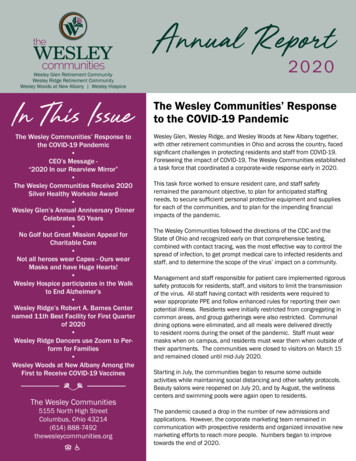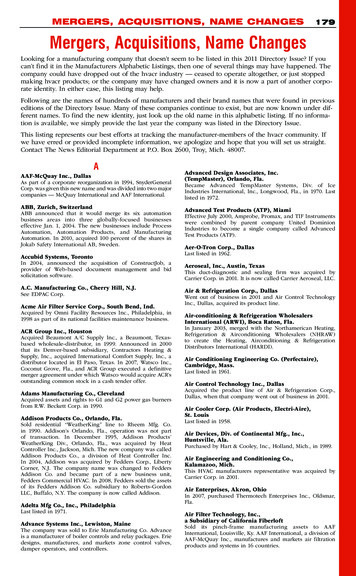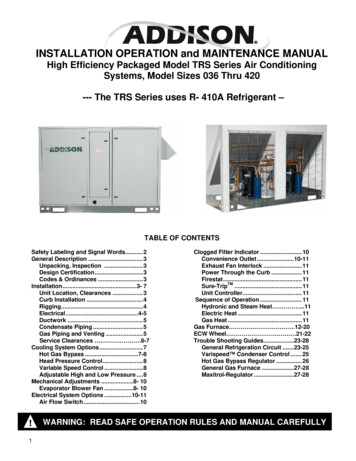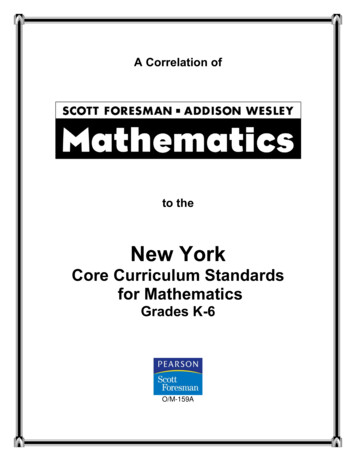
Transcription
A Correlation ofto theNew YorkCore Curriculum Standardsfor MathematicsGrades K-6O/M-159A
IntroductionThis document demonstrates the high degree of success students will achieve when usingScott Foresman – Addison Wesley Mathematics in meeting the objectives of the New YorkLearning Standards for Mathematics. Correlation page references are to the Teacher’s Edition.Lessons in the Teacher’s Edition contain facsimile Student Edition pages.Scott Foresman – Addison Wesley Mathematics was carefully developed to reflect thespecific needs of students and teachers at every grade level, while maintaining an overallprimary goal: to have math make sense from every perspective. This program is based onscientific research that describes how children learn mathematics well and on classroom-basedevidence that validates proven reliability.z Reaching All LearnersScott Foresman – Addison Wesley Mathematics addresses the needs of every studentthrough structured instruction that makes concepts easier for students to grasp. Lessonsprovide step-by-step examples that show students how to think about and solve the problem.Built-in leveled practice in every lesson allows the teacher to customize instruction to matchstudents’ abilities. Reaching All Learners, featured in the Teacher Edition, helps teachers meetthe diverse needs of the classroom with fun and stimulating activities that are easy toincorporate directly into the lesson plan.z Test PrepScott Foresman - Addison Wesley Mathematics builds understanding through connections toprior knowledge, math strands, other subjects and the real world. It provides practice formaximum results and offers assessment in a variety of ways. Besides carefully placed reviewsat the end of each Section, an important Test Prep strand runs throughout the program. Writingexercises prepare students for open-ended and short-or extended-response questions on stateand national tests. Spiral review in a test format help students keep their test-taking skills sharp.z Priority on problem solving:Problem-solving instruction is systematic and explicit. Reading connections help children withproblem-solving skills and strategies for math. Reading for Math Success encourages studentsto use the reading skills and strategies they already know to solve math problems.z Instructional SupportIn the Teacher Edition, the Lesson Planner provides an easy, at-a-glance planning tool. Itidentifies objectives, math understandings, focus questions, vocabulary, and resources for eachlesson in the chapter. Professional Development at the beginning of each chapter in theTeacher Edition includes a Skills Trace as well as Math Background and Teaching Tips for eachsection in the chapter.Ancillaries help to reach all learners with practice, problem solving, hands-on math, languagesupport, assessment and teacher support. Technology resources for both the student and theteacher provide a whole new dimension to math instruction by helping to create motivating andengaging lessons.
Table of ContentsKindergarten . . . . 1Grade One . . 10Grade Two . . 22Grade Three . . .32Grade Four . .44Grade Five . .56Grade Six . .69
Scott Foresman – Addison Wesley Mathematicsto theNew York Core Curriculum Mathematics StandardsKindergartenPROCESS STRANDSProblem Solving StrandStudents will: build new mathematical knowledge through problem solving; solve problems that arise in mathematics and in other contexts; apply and adapt a variety of appropriate strategies to solve problems; monitor and reflect on the process of mathematical problem solving.Open-ended problems are found throughout the text, including specific Problem Solvinglessons in each chapter. The Teacher’s Edition also provides prompts to help childrenvocalize their thoughts about solving problems. Problem Solving lessons that focus onunderstanding and applying individual strategies appear in every chapter. In addition, aProblem Solving Applications lesson appears at the end of every chapter, providingchildren with opportunities to apply strategies learned from the current chapter andprevious chapters to solve real-world problems.Reasoning and Proof StrandStudents will: recognize reasoning and proof as fundamental aspects of mathematics; make and investigate mathematical conjectures; develop and evaluate mathematical arguments and proofs; select and use various types of reasoning and methods of proof.Children will use inductive and/or deductive reasoning in the Logical Thinking problemspresented in each chapter of the text. Additionally, questions provided in the Teacher’sEdition will help promote the use of logic in children’s reasoning. Throughout theprogram, children are presented with ample opportunities to make oral generalizationsKindergarten1
New York Core Curriculum Mathematics StandardsScott Foresman – Addison Wesley Mathematicsabout the concepts taught in each lesson and to test those generalizations. In mostlessons, children are given opportunities to check, revise, explain, and/or justify theirsolutions. Additionally, many problems ask children to judge the solutions of others,correcting them if necessary.Communication StrandStudents will: organize and consolidate their mathematical thinking through communication; communicate their mathematical thinking coherently and clearly to peers,teachers, and others; analyze and evaluate the mathematical thinking and strategies of others; use the language of mathematics to express mathematical ideas precisely.Most lessons give children the opportunity to express their solutions in multiple ways,such as by using numbers and manipulatives. Error Intervention suggestions in theTeacher’s Edition often encourage the use of multiple representations to demonstrateunderstanding of key concepts or solution methods. Suggested prompts and questionsprovided in the Teacher’s Edition may be used to stimulate discussion and elicitstudents’ questions. Each lesson includes Investigating the Concept and Reaching AllLearners activities in the Teacher’s Edition designed for students to discuss and worktogether as a whole class, as a small group, or in pairs. Students are encouraged towork cooperatively and respectfully with one another and give helpful comments andsuggestions.Connections StrandStudents will: recognize and use connections among mathematical ideas;; understand how mathematical ideas interconnect and build on one another toproduce a coherent whole; recognize and apply mathematics in contexts outside of mathematics.Through the logical progression of lessons, students continually build an understandingof new mathematical concepts on a firm foundation of previously taught concepts. Eachlesson begins with a prompt in the Teacher’s Edition to Activate Prior Knowledge, whichwill help students make connections between previously learned mathematical conceptsand new concepts. Review questions at the end of sections and chapters will also helpstudents connect previously learned concepts to new ones. Cross-curricular activitiesthroughout the text connect math concepts to other disciplines, such as art, health,literature, music, physical education, science, social studies, and technology.Kindergarten2
New York Core Curriculum Mathematics StandardsScott Foresman – Addison Wesley MathematicsRepresentation StrandStudents will: create and use representations to organize, record, and communicatemathematical ideas; select, apply, and translate among mathematical representations to solveproblems; use representations to model and interpret physical, social, and mathematicalphenomena.Students use concrete and pictorial representations to visualize, analyze, and expressmathematical concepts throughout the text. Examples found throughout the text requirestudents to represent real-world mathematical situations in a variety of ways. GettingStarted and Reaching All Learners activities in the Teacher’s Edition for each lessonprompt students to use multiple ways to represent the lessons’ underlying mathematicalconcepts.CONTENT STRANDSNUMBER SENSE AND OPERATIONS STRANDStudents will understand numbers, multiple ways of representing numbers,relationships among numbers, and number systems.Number SystemsK.N.1 Count the items in a collection and know the last counting word tellshow many items are in the collection (1 to 10)Lesson 3-1, pp. 53A–53B, 53–54; Lesson 3-2, p. 56; Lesson 3-3, pp. 57A–57B, 57–58; Lesson 3-4, p. 60; Lesson 3-6, pp. 63A–63B, 63–64; CH.4 Investigations p. 75I;CH. 4 Center Activities p. 75L; Lesson 4-1, pp. 77A–77B, 77–78; Lesson 4-2, pp.79A–79B, 79–80; Lesson 4-3, p. 82; Lesson 4-4, pp. 83A–83B, 83–84; Lesson 4-5,p. 86; Lesson 4-6, pp. 87A–87B, 87–88; CH. 5 Investigation, p. 101I; Lesson 7-10,pp. 179A–179B, 179–180; Lesson 12-1, pp. 287A–287BK.N.2 Count out (produce) a collection of a specified size 1 to 10Lesson 3-1, pp. 53A–53B, 53–54; Lesson 3-3, pp. 57A–57B, 57–58; CH. 4Investigations, p. 75I; CH. 4 Center Activities, p. 75L; Lesson 4-1 pp. 77A–77B, 77–78; Lesson 4-2, pp. 79A–79B, 79–80; Lesson 4-4, pp. 83A–83B, 83–84; Lesson 411, p. 97B; Lesson 9-1, p. 225B; Lesson 9-2, pp. 227A–227B; Lesson 9-3, pp.229A–229B; Lesson 9-4, pp. 231A–231B; Lesson 10-4, pp. 251A–251B; Lesson 107, pp. 257A–257B; Lesson 12-1, p. 287A; Lesson 12-3, pp. 291A–292B; Lesson 125, p. 295AKindergarten3
New York Core Curriculum Mathematics StandardsScott Foresman – Addison Wesley MathematicsK.N.3 Numerically label a data set of 1 to 5.CH. 3 Center Activities, p. 51K; Lesson 3-1, pp. 53A–53B, 53–54; Lesson 3-2, pp.55A–55B, 55–56; Lesson 3-3, pp. 57A–57B, 57–58; Lesson 3-4, pp. 59A–59B, 59–60; Lesson 7-10, pp. 179A–179B, 179–180; Lesson 9-1, pp. 225A–225B; Lesson 92, pp. 227A–227B, 227–228; Lesson 9-3, pp. 229A–229B, 229–230; Lesson 9-4, pp.231–232; Lesson 9-5, pp. 233A–233B, 233–234; Lesson 9-8, pp. 239–242K.N.4 Verbally count by 1’s to 20Lesson 3-1, pp. 53A–53B, 53–54; Lesson 3-2, pp 57A–57B, 57–58; CH. 4Investigations, p. 75I; CH. 4 Center Activities, p. 75L; Lesson 4-1, pp 77A–77B, 77–78; Lesson 4-2, pp. 79A–79B, 79–80; Lesson 4-4, pp. 83A–83B, 83–84; CH. 5Investigations, p. 101I; CH. 5 Center Activities, pp. 101K–101L; Lesson 5-1, pp103A–103B, 103–104K.N.5 Verbally count backward from 10Lesson 4-8, pp. 91A–91B, 92 activityK.N.6 Represent collections with a finger pattern up to 10Lesson 3-10, p. 71B; Lesson 4-7, p. 89B; Lesson 9-4, p. 231BK.N.7 Draw pictures or other informal symbols to represent a spoken numberup to 10Lesson 3-2, pp. 55; Lesson 3-4, p. 59; Lesson 3-7, p. 66; Lesson 3-10, p. 71B;Lesson 4-1, pp. 77B, 77; Lesson 4-2, p. 79; Lesson 4-4, p. 83; Lesson 4-7, pp. 89A–89B, 89–90; Lesson 4-11, p. 97BK.N.8 Draw pictures or other informal symbols to represent how many in acollection up to 10Lesson 3-1, pp. 53A–53B, 53–54; Lesson 3-3, pp. 57A–57B, 57–58; Lesson 4-1, pp77A–77B, 77–78; Lesson 4-2, pp. 79A–79B, 79–80; Lesson 4-4, pp. 83A–83B, 83–84; Lesson 9-7, p. 237B; Lesson 9-8, pp. 239A–239B; Lesson 10-3, pp. 249A–249B,249–250; Lesson 10-4, pp. 251A–251B; Lesson 11-2, pp. 267A–267B; Lesson 11-3,p. 269A; Lesson 11-4, p. 271A; Lesson 11-6, p. 275A; Lesson 11-8, p. 279B; Lesson12-7, pp. 299A–299BK.N.9 Write numbers 1-10 to represent a collectionLesson 3-2, pp. 55A–55B, 55–56; Lesson 3-4, pp. 59A–59B, 59–60; CH. 4 CenterActivities, p. 75L, Lesson 4-3, pp. 81A–81B, 81–82; Lesson 4-5, pp. 85A–85B, 85–86; Lesson 9-1, pp. 225–226; Lesson 9-2, pp. 227B, 227–228; Lesson 9-3, pp. 229–230; Lesson 9-4, pp. 231–232; Lesson 9-5, pp. 233A–233B, 233–234; Lesson 9-6,pp. 235–236; Lesson 9-7, pp. 237–238; Lesson 9-8, pp. 239A–239B, 239–242;Kindergarten4
New York Core Curriculum Mathematics StandardsScott Foresman – Addison Wesley MathematicsLesson 10-2, pp. 247–248; Lesson 10-3, pp. 249A–249B, 249–250; Lesson 10-4,pp. 251A–251B, 251–252; Lesson 10-5, pp. 253B, 253–254; Lesson 10-6, pp. 255A,255–256; Lesson 10-7, pp. 257A–257B, 257–258; Lesson 10-8, pp. 259A–259B,259–262; Lesson 11-1, pp. 265–266; Lesson 11-2, pp. 267–268; Lesson 11-3, pp.269A–269B, 269–270; Lesson 11-5, pp. 273A–273B, 273–274; Lesson 11-6, pp.275A–275B, 275–276; Lesson 11-7, pp. 277A–277B, 277–278; Lesson 11-9, pp.281A–281B, 281–282; Lesson 12-1, p. 288; Lesson 12-7, pp. 299A–299B, 300K.N.10 Visually determine how many more or less, and then using the verbalcounting sequence, match and count 1-10CH. 3 Investigation, p. 51J; Lesson 3-6, pp. 63A–63B, 63–64; Lesson 4-6,pp. 87–88; Lesson 4-7, pp. 89–90; Lesson 4-11, p. 97A; Lesson 11-3pp. 269A-269B, 269-270K.N.11 Use and understand verbal ordinal terms, first to tenthLesson 3-9, pp. 69A–69B, 69–70; Lesson 4-9, pp. 93A–93B, 93–94Students will understand meanings of operations and procedures, and how theyrelate to one another.OperationsK.N.12 Solve and create addition and subtraction verbal word problems(use counting-based strategies, such as counting on and to ten)CH. 9 Investigations, pp. 223I, 223J; CH. 9 Center Activities, p. 223L; Lesson 9-8,pp. 239A–239B, 239–240; Lesson 10-1, pp. 245A–245B, 245–246; Lesson 10-8,pp. 259A–259B, 259–260; Lesson 11-1, p. 266; Lesson 11-9, pp. 281A–281B, 281–282; Lesson 9-6, p. 235A; Lesson 9-7, p. 237A; Lesson 10-3, pp. 249A–249B;Lesson 11-8, pp. 279A–279BK.N.13 Determine sums and differences by various meansLesson 9-6, pp. 235A–235B, 235–236; Lesson 9-8, pp. 241–242; Lesson 10-4,pp. 251A–251B, 251–252; Lesson 10-5, pp. 253A–253B, 253–254; Lesson 10-6,pp. 255A–255B, 255–256; Lesson 10-7, pp. 257A–257B, 257–258; Lesson 10-8,pp. 259A–259B, 259–260; Lesson 11-4, pp. 271A–271B, 271–272; Lesson 11-5,pp. 273A–273B, 273–274; Lesson 11-6, pp. 275A–275B, 275–276; Lesson 11-7,pp. 277A–277B, 277–278; Lesson 11-8, pp. 279A–279B, 279–280; Lesson 11-9,pp. 281A–281B, 281–282; Lesson 9-7, p. 237A–237B, 237–238; Lesson 10-2,pp. 247A–247B, 247–248; Lesson 10-3, pp. 249A–249B, 249–250; Lesson 11-1,pp. 265A–265B, 265–266; Lesson 11-2, pp. 267A–267B, 267–268Kindergarten5
New York Core Curriculum Mathematics StandardsScott Foresman – Addison Wesley MathematicsALGEBRA STRANDStudents will recognize, use, and represent algebraically patterns, relations, andfunctions.Patterns, Relations and FunctionsK.A.1 Use a variety of manipulatives to create patterns using attributes ofcolor, size, or shapeCH. 2 Center Activities, p. 25L; Lesson 2-6, pp. 37A–37B, 37–38; Lesson 2-7,pp. 39A–39B, 39–40; Lesson 2-10, pp. 45A–45B, 45–46; Lesson 4-10,pp. 95A–95B, 95–96K.A.2 Recognize, describe, extend, and create patterns that repeat (e.g.,ABABAB or ABAABAAAB)CH.2 Center Activities, p. 25L; Lesson 2-5, pp. 35A–35B, 35–36; Lesson 2-6, pp.37A–37B, 37–38; Lesson 2-7, pp. 39A–39B, 39–40; Lesson 2-8, pp. 41A–41B, 41–42; Lesson 2-9, pp. 43A–43B, 43–44; Lesson 2-10, pp. 45A–45B, 45–46; Lesson 211, pp. 48, 50; Lesson 4-10, pp. 95A–95B, 95–96; Lesson 12-2, pp. 289A–289B,289; Lesson 12-4, pp. 293A–293B; Lesson 12-6, pp. 297A–297B, 297–298; Lesson12-7, p. 299BGEOMETRY STRANDStudents will use visualization and spatial reasoning to analyze characteristicsand properties of geometric shapes.ShapesK.G.1 Describe characteristics and relationships of geometric objectsCH. 8 Investigation, p. 195I; CH. 8 Center Activities, pp.195K–195L; Lesson 8-1,pp. 197A–197B, 197–198; Lesson 8-2, pp. 199A–199B, 199–200; Lesson 8-3,pp. 201A–201B, 201–202; Lesson 8-4, pp. 203A–203B, 203–204; Lesson 8-5,pp. 205A–205B, 205–206; Lesson 8-6, pp. 207A–207B, 207–208; Lesson 8-7,pp. 209A–209B, 209–210; Lesson 8-12, pp. 219A–219B, 221Kindergarten6
New York Core Curriculum Mathematics StandardsScott Foresman – Addison Wesley MathematicsStudents will identify and justify geometric relationships, formally and informally.Geometric RelationshipsK.G.2 Sort groups of objects by size and size order (increasing anddecreasing)Lesson 1-6, pp. 13A–13B, 13–14; Lesson 1-7, pp. 15A–15B, 15–16; Lesson1-8, pp. 17A–17B, 17–18; Lesson 6-1, 133A–133B, 133–134; Lesson 6-3, pp.137A–137B, 137–138Students will apply transformations and symmetry to analyze problem solvingsituations.Transformational GeometryK.G.3 Explore vertical and horizontal orientation of objectsRelated content: CH. 8 Investigation, p. 195J; Lesson 8-6, pp. 207A–207B,207–208K.G.4 Manipulate two- and three-dimensional shapes to explore symmetryLesson 8-8, pp. 211A–211B, 211–212; Lesson 8-6, pp. 207A–207B, 207–208;Lesson 8-12, p. 222Students will apply coordinate geometry to analyze problem solving situations.Coordinate GeometryK.G.5 Understand and use ideas such as over, under, above, below, on,beside, next to, and betweenCH. 1 Center Activities, pp.1K, 1L; Lesson 1-1, pp. 3A–3B, 3–4; Lesson 1-2, pp. 5A–5B, 5–6; Lesson 1-3, pp. 7A–7B, 7–8; Lesson 1-4, pp. 9A–9B, 9–10; Lesson 1-10,pp. 21A–21B, 21–23Kindergarten7
New York Core Curriculum Mathematics StandardsScott Foresman – Addison Wesley MathematicsMEASUREMENT STRANDStudents will determine what can be measured and how, using appropriatemethods and formulas.Units of MeasurementK.M.1 Name, discuss, and compare attributes of lengthCH. 6 Investigation, p. 131I; Lesson 6-2, pp. 135A–135B, 135–136; Lesson 6-3, pp.137A–137B, 137–138K.M.2 Compare the length of two objects by representing each length withstring or a paper stripLesson 6-2, pp. 135A–135B, 135–136; Lesson 6-3, p. 137BK.M.3 Relate specific times such as morning, noon, afternoon, and evening toactivities and absence or presence of daylightLesson 7-6, pp. 171A–171B, 171–172STATISTICS AND PROBABILITY STRANDStudents will collect, organize, display, and analyze data.Collection of DataK.S.1 Gather data in response to questions posed by the teacher and studentsCH. 2 Center Activities, p. 25K; Lesson 2-4, pp. 33A–33B, 33–34; Lesson 2-11, pp.47A–47BOrganization and Display of DataK.S.2 Help to make simple pictographs for quantities up to 10, where onepicture represents 1Lesson 2-3, pp. 31A–31B, 31–32; Lesson 3-8, pp. 67A–67B, 67–68; Lesson 2-11,pp. 47A–47B, 49K.S.3 Sort and organize objects by two attributes (e.g., color, size, or shape)Lesson 1-8, pp. 17A–17B, 17–18; Lesson 1-10, pp. 22, 24; Lesson 9-1, pp.225A–225B; Lesson 9-2, pp. 227A–227B; Lesson 9-3, pp. 229A–229B;Lesson 9-4, pp. 231A–231B; Lesson 9-5, pp. 233A–233B; Lesson 9-8, pp.239A–239B; Lesson 10-8, pp. 259A–259B, 259–260; Lesson 11-9, pp.281A–281B, 281–282Kindergarten8
New York Core Curriculum Mathematics StandardsScott Foresman – Addison Wesley MathematicsK.S.4 Represent data using manipulativesCH. 2 Center Activities, p. 25K; Lesson 2-2, pp. 29A–29B, 29–30; Lesson 2-3, pp.31A–31B, 31–32; Lesson 2-4, pp. 33A–33B, 33–34Analysis of DataK.S.5 Identify more, less, and same amounts from pictographs or concretemodelsCH. 2 Investigation, p. 25I; CH. 2 Center Activities, p. 25K; Lesson 2-1, pp. 27A–27B,27–28; Lesson 2-2, pp. 29A–29B, 29–30; Lesson 2-3, pp. 31–31B, 31–32; Lesson 2-11,pp. 47B, 47, 49; Lesson 4-11, p. 97A–97B, 97, 99–100; Lesson 6-7, pp. 145A–145B,145–146; Lesson 7-9, pp. 177A–177B, 177–178; Lesson 7-15, pp. 189A–189B, 189–190; Lesson 8-9, pp. 213A–213B, 213–214; Lesson 8-10, pp. 215A–215B, 215–216;Lesson 8-11, pp. 217A–217B, 217–218; Lesson 8-12, pp. 220, 222; Lesson 8-12, p. 222Kindergarten9
Scott Foresman – Addison Wesley Mathematicsto theNew York Core Curriculum Mathematics StandardsGrade OnePROCESS STRANDSProblem Solving StrandStudents will: build new mathematical knowledge through problem solving; solve problems that arise in mathematics and in other contexts; apply and adapt a variety of appropriate strategies to solve problems; monitor and reflect on the process of mathematical problem solving.Students are challenged to use alternate ways to solve problems throughout the text,and many problems are open to students’ choice of solution methods. Students haveopportunities to apply problem-solving skills in the Problem-Solving section at the end ofmost lessons and in the Problem-Solving lessons found in each chapter. Instructionalsupport in the Teacher’s Edition for these lessons provides questions and prompts thatencourage students to orally describe or explain how they plan to solve these problems.Reasoning and Proof StrandStudents will: recognize reasoning and proof as fundamental aspects of mathematics;make and investigate mathematical conjectures;develop and evaluate mathematical arguments and proofs;select and use various types of reasoning and methods of proof.Students will use inductive and/or deductive reasoning in the Reasoning problemspresented throughout each chapter of the text. Throughout the program, students arepresented with ample opportunities to make oral generalizations about the conceptstaught in each lesson and to test those generalizations. In most lessons, students aregiven opportunities to check, revise, explain, and/or justify their work.Grade One10
New York Core Curriculum Mathematics StandardsScott Foresman – Addison Wesley MathematicsCommunication StrandStudents will: organize and consolidate their mathematical thinking through communication; communicate their mathematical thinking coherently and clearly to peers,teachers, and others; analyze and evaluate the mathematical thinking and strategies of others; use the language of mathematics to express mathematical ideas precisely.Think About It and Writing in Math questions appear throughout the text. Open-endedquestions on assessment pages also provide opportunities for students to express theirsolutions in numerical and written forms. Suggested prompts and questions provided inthe Teacher’s Edition may be used to stimulate discussion and elicit students’questions. Each lesson includes Investigating the Concept and Reaching All Learnersactivities in the Teacher’s Edition designed for students to discuss and work together asa whole class, as a small group, or in pairs. Students are encouraged to workcooperatively and respectfully with one another and give helpful comments andsuggestions.Connections StrandStudents will: recognize and use connections among mathematical ideas; understand how mathematical ideas interconnect and build on one another toproduce a coherent whole; recognize and apply mathematics in contexts outside of mathematics.Through the logical progression of lessons, students continually build an understandingof new mathematical concepts on a firm foundation of previously taught concepts. Eachlesson begins with a prompt in the Teacher’s Edition to Activate Prior Knowledge, whichwill help students make connections between previously learned mathematical conceptsand new concepts. Review questions at the end of sections and chapters will also helpstudents connect previously learned concepts to new ones. Exercises provided in mostlessons will help students recognize the widespread application of mathematicalconcepts to real-world situations. Cross-curricular activities throughout the text connectmath concepts to other disciplines, such as art, health, literature, music, physicaleducation, science, social studies, and technology.Grade One11
New York Core Curriculum Mathematics StandardsScott Foresman – Addison Wesley MathematicsRepresentation StrandStudents will: create and use representations to organize, record, and communicatemathematical ideas; select, apply, and translate among mathematical representations to solveproblems; use representations to model and interpret physical, social, and mathematicalphenomena.Students use concrete and pictorial representations to visualize, analyze, and expressmathematical concepts throughout the text. Examples found throughout the text requirestudents to represent real-world mathematical situations in a variety of ways. GettingStarted and Reaching All Learners activities in the Teacher’s Edition for each lessonprompt students to use multiple ways to represent the lessons’ underlying mathematicalconcepts.CONTENT STRANDSNUMBER SENSE AND OPERATIONS STRANDStudents will understand numbers, multiple ways of representing numbers,relationships among numbers, and number systems.Number Systems1.N.1 Count the items in a collection and know the last counting wordtells how many items are in the collection (1 to 100)Readiness, pp. R1, R2, R3, R4, R5, R7, R8; Lesson 2-1, p. 45B; Ch. 9Investigation, p. 239I; Lesson 7-13, p. 269B; Lesson 8-17, pp. 319A-319B,319-3201.N.2 Count out (produce) a collection of a specified size (10 to 100 items), usinggroups of tenReadiness, p. R8; 239I, Lesson 7-1, pp. 241A-241B; Lesson 7-13, p. 269B1.N.3 Quickly see and label with a number, collections of 1 to 10Readiness, pp. R1, R2, R3, R4, R5, R7, R8; Lesson 1-8, p. 21B1.N.4 Count by 1’s to 100Lesson 1-6, pp. 17A-17B, 17-18; Lesson 3-1, 91A-91B, 91-92; Lesson 7-3,p. 245A; Lesson 8-6, pp. 295A-295B, 295-296Grade One12
New York Core Curriculum Mathematics StandardsScott Foresman – Addison Wesley Mathematics1.N.5 Skip count by 10’s to 100Lesson 7-2, pp. 243A–243B, 243–244; Lesson 7-6, pp. 251-252; Lesson 7-7,pp. 255A-255B, 255-256; Lesson 7-8, pp. 257A-257B, 257-258; Lesson 7-13,p. 269B; Ch.7 Enrichment, p. 273; Lesson 8-6, pp. 295A-295B, 295-2961.N.6 Skip count by 5’s to 50Lesson 7-7, pp. 255A–255B, 255–256; Lesson 7-8, pp. 257A–257B, 257–258;Lesson 7-9, pp. 259–260; Lesson 7-13, pp. 269B, 269; Ch. 7, Learning WithTechnology, p. 2741.N.7 Skip count by 2’s to 20Lesson 7-7, pp. 255A–255B, 255–256; Lesson 7-8, pp. 257A–257B, 257–258;Lesson 7-9, pp. 261A-261B, 261-262; Lesson 7-13, pp. 269B, 269-270; Ch. 7Learning With Technology, p. 2741.N.8 Verbally count from a number other than one by 1’sLesson 7-3, pp. 245B, 245–2461.N.9 Count backwards from 20 by 1’sReadiness, pp. R6; Lesson 1-7, pp. 19A-19B, 19-20; Lesson 2-4, p. 51B; Lesson4-1, pp. 125A-125B, 125-126; Lesson 4-2, pp. 127A-127B, 127-128; Ch. 7Home-School Connection, p. 239J; Lesson 7-3, pp. 245A–245B, 245-246;Lesson 8-6, pp. 295A-295B, 295-2961.N.10 Draw pictures or other informal symbols to represent a spoken number upto 20Related content: Lesson 7-1, pp. 241A–241B, 241–2421.N.11 Identify that spacing of the same number of objects does not affectthe quantity (conservation)See Grade K.1.N.12 Arrange objects in size order (increasing and decreasing)See Grade K.1.N.13 Write numbers to 100Many lessons provide students with the opportunity to meet this performance indicator.Here are a few of the many examples. Ch. 1, Investigation, p. 1J; Ch. 3 Investigation,p. 89l, Ch. 3 Math Story, p. 89J; Lesson 3-1, pp. 91A-91B, 91-92; Lesson 7-1, pp. 241A241B, 241-242, Lesson 7-2, pp. 243A-243B, 243-244; Lesson 7-3, pp. 245A-245B, 245246; Ch. 8 Investigation, p. 297l: Lesson 8-1, pp. 281A-281B, 281-282; Lesson 8-2, pp.283A-283B, 283-284; Lesson 8-3, pp. 285A-285B, 285-286; Lesson 8-4, pp. 287A287B, 287-288; Ch. 9 Investigation, p. 329l; Lesson 9-1, pp. 331A-331B, 331-332;Grade One13
New York Core Curriculum Mathematics StandardsScott Foresman – Addison Wesley MathematicsLesson 9-2, pp. 333A-333B, 333-334; Lesson 9-3, pp. 335A-335B, 335-336; Lesson 94, pp. 337A-337B, 337-338; Lesson 9-5, pp. 339A-339B, 339-340; Lesson 9-6, pp.343A-343B, 343-344; Lesson 9-7, pp. 345A-345B, 345-346; Lesson 9-10, p. 353, Ch. 9Learning With Technology, p. 358; Lesson 11-13, pp. 445A-445B, 445-446; Lesson 1114, pp. 447A-447B, 447-4481.N.14 Read the number words one, two, three tenReadiness, pp. R1, R2, R3, R4, R5, R8, 1K–1L; Ch. 1, Discover Math in YourWorld, p. 40; Ch. 7, Practice Game, p. 2401.N.15 Explore and use place valueLesson 7-1, pp. 241A–241B, 241–242; Lesson 7-4, pp. 247A–247B, 247–248;Lesson 8-2, pp. 283A–283B, 283–284; Lesson 8-3, pp. 285A–285B, 285–286;Lesson 8-4, pp. 287A–287B, 287–288; Lesson 8-5, p. 291-292; Lesson 8-10,pp. 303A–303B, 303–3041.N.16 Compare and order whole numbers up to 100Lesson 1-8, pp. 21A-21B, 21-22; Lesson 1-9, pp. 23A-23B, 23-24; Lesson 2-13,pp. 75A-75B, 75-76; Lesson 2-14, pp. 77A-77B, 77-78, Lesson 8-6, pp. 295A295B, 295-296; Lesson 8-7, pp. 297A-297B, 297-298; Lesson 8-9, pp. 301A301B, 301-302; Lesson 9-5, pp. 339A-339B, 339-3401.N.17 Develop an initial understanding of the base ten system:10 ones 1 ten10 tens 1 hundredCh. 8 Investigation, p. 279I; Lesson 8-1, pp. 281A–281B, 281–282; Lesson 8-2,pp. 283A–283B, 283–284, Lesson 8-3, pp. 285A–285B, 285–286; Lesson 8-4,pp. 287A–287B, 287–288; Lesson 11-4, pp. 423A–423B, 423–424; Lesson 1111, pp. 441A–441B, 441–442; Lesson 12-6, pp. 471A–471B, 471–472; Lesson12-7, pp. 473A–473B, 473–4741.N.18 Use a variety of strategies to compose and decompose one-digitnumbersOn these pages students compose and decompose two–digit numbers.Lesson 1-2, pp. 5A–5B, 5–6; Lesson 1-3, pp. 7A–7B, 7–8; Lesson 15, pp. 13A-13B, 13-14; Lesson 1-6, pp. 17A-17B, 17-18; Ch. 8 Investigation, p.279l1.N.19 Understand the commutative property of additionLesson 3-2, pp. 93A–93B, 93–94; Lesson 11-6, pp. 427A–427B, 427–4281.N.20 Name the number before and the number after a given number, andname the number(s) between two given numbers up to 100 (with and without theuse of a number line or a hundreds chart)Lesson 7-10, pp. 263A–263B, 263–264; Lesson 8-8, pp. 299A–299B, 299–300;Lesson 8-9, pp. 301A–301B, 301–302Grade One14
New York Core Curriculum Mathematics StandardsScott Foresman – Addison Wesley Mathematics1.N.21 Use before, after, or between to order numbers to 100 (with orwithout the use of a number line)Lesson 7-10, pp. 263A–263B, 263–264; Lesson 8-8, pp. 299A–299B, 299–300;Lesson 8-9, pp. 301A–301B, 301–3021.N.22 Use the words higher, lower, greater, and less to compare twonumbersLesson 1-8, pp. 21A–21B; Lesson 2-13, pp. 75A–75B, 75–76; Lesson 2-14, pp.77A–77B, 77–78; Lesson 2-15, pp. 79A, 81; Lesson 3-3, pp. 95A-95B, 95-96;Lesson 8-6, pp. 295A–295B, 295–296; Lesson 8-7, pp. 297A–297B, 297–298;Lesson 8-9, pp. 301A–301B, 301–302; Lesson 10-18, p. 4081.N.23 Use and understand verbal ordinal terms, first to twentiethCh. 7, Practice Game, p. 240; Lesson
Scott Foresman - Addison Wesley Mathematics was carefully developed to reflect the specific needs of students and teachers at every grade level, while maintaining an overall primary goal: to have math make sense from every perspective. This program is based on
